It’s 10:30am. Cuenca is a bustle of activity.
There is a woman sitting outside of an auto parts shop on a plastic stool, cracking open walnuts with a sledgehammer.
Beyond her is a man standing on the sidewalk with a plastic bucket full of freshly plucked raw honeycombs for sale.
Just inside a dark storefront, llapingachos (Ecuadorian potato cakes) are sizzling, alongside a pot of steaming tamales and another wok of pork pieces.
This post was originally published in 2016. It has since been updated for accuracy of links and content.
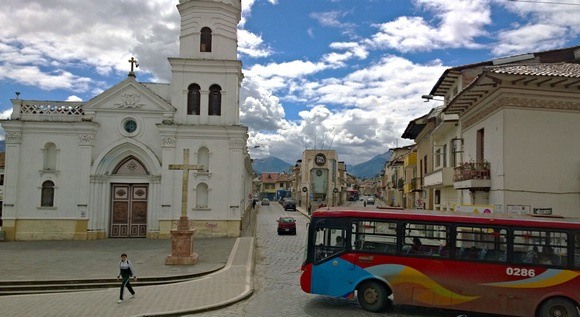
A woman in indigenous dress walks by me with a basket over her arm filled with baked goods.
As I walk, every three doors I pass by a panaderia (bakery) pumping out the most pleasant (and simultaneously agonizing) smell in the world: that of freshly baked bread.
Just outside the fresh market there is a pot of burning palo santo (a form of Andean incense with shamanic cleansing properties), and vendors of all sorts are selling random items like Ecuadorian flags and shorts, sandals, leggings, bags of avocados and mangoes, lottery tickets, and brooms.
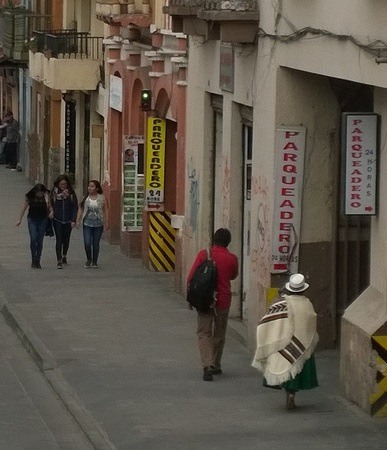
On my way home from the market, another indigenous woman is standing by a wheelbarrow filled to the brim with perfectly arranged strawberries, apricots, mandarins, grapes, cherimoya, and avocados.
Another woman, toddler in hand, is standing on the corner with a large basket filled with bags of homemade chifles (fried plantain slices – like potato chips laced with crack; they’re very addictive) and potato chips.
A man bumps into her on his way through the intersection, balancing a long pole on his shoulder with bags of caramel corn hanging off it.
And every afternoon a man parks on my street with a cart full of water coconuts, strawberries, guavas, and coconut pieces.
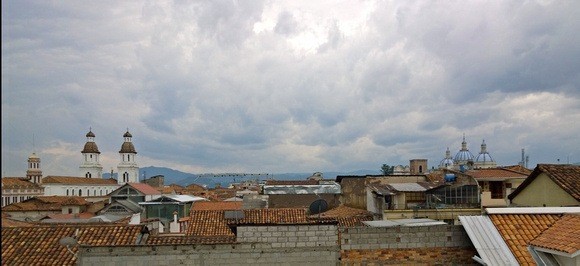
Life in Cuenca is alive and well, and the hum of so many different walks of life is tangible.
Since my introduction to Cuenca, I stayed in El Centro for six weeks. It’s an intriguing place, and I easily could have stayed much longer. However, I’m not sure it’s a place I’d like to live (like, “forever” kind of live). To be honest, the place kind of confuses me….and intrigues me at the same time.
Confused yet? Join the club. Here are some further observations I’ve had in my six weeks of calling Cuenca “home”.
Food: Meh?
My description above is largely centred around food and street vendors. One of the rumours I heard on arrival is that Ecuadorian street food is largely non-existent. This of course, isn’t true, but it’s a far cry from SE Asia’s food carts with freshly made delicacies like pho and pad thai.
Another common sentiment about Ecuadorian food is that it’s boring. I met up with one expat who expressed a sore disappointment at the restaurants in Cuenca, saying she doesn’t find the food inspiring.
I’ll admit, Ecuadorian cuisine (what I had of it) pales in comparison to that of its neighbour to the south (Peru). But I had some lovely encebollados (soups), cazuelas (casserole/stews), and ceviche de camarones (an interesting form of ceviche with cooked shrimp that reminded me of a watered-down shrimp cocktail – which tastes better than it sounds).
My response to the woman’s complaint about Ecuadorian cuisine being boring? For boring, she should try Panama or Costa Rica. (Sorry, guys).
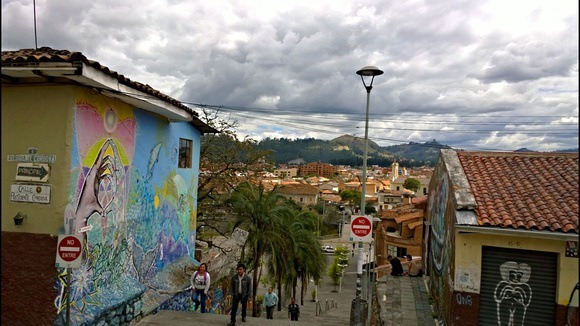
Interestingly, there are a lot of restaurants of varying cuisines in Cuenca – notably Italian, Mexican, and American. Many of these restaurants aren’t just for expats; in fact I often saw more Ecuadorian faces than foreigners. And in some cases, given the high menu prices, I found it a bit confusing.
Confusing Cost of Living
In my first post about Cuenca, I mentioned the cheap cost of living along with the use of the US Dollar. As I spent time in Cuenca, I found an increasingly conflicting diversity of prices.
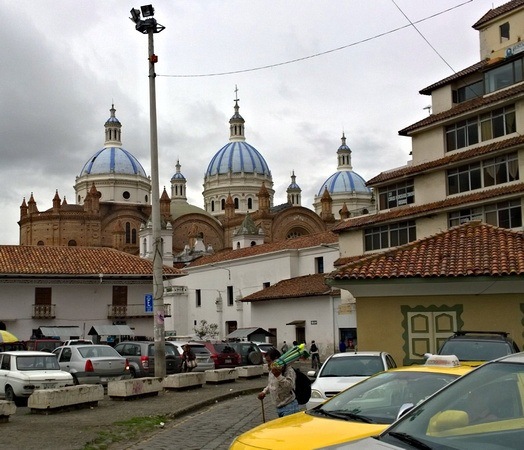
I could buy a week’s worth of vegetables and an obscene amount of exotic fruit at the fresh market for $10. And then I could go to a cafe and spend $3 on a cappuccino, and later to a restaurant with $15 entrees – American prices in a developing country. And although you’d think these cafes and restaurants would only be attended by expats, instead they were filled with Ecuadorians.
The cost of living in Ecuador is certainly higher than in Peru, where they use the Peruvian Sol for currency. Many of the same items in markets and grocery stores cost roughly the same – in Soles, which is 1/3 of the value of the dollar.
I wonder if it’s the use of the US Dollar. I saw a similar situation in Panama, where the average wage wasn’t that high, but the super-mall full of designer stores (sporting American prices) was consistently full to capacity, with Panamanians. I also found Costa Rica (with the widely used US Dollar) had similar prices to the States, and I wondered how the locals could afford it – but somehow they do.
Safety, Walkability
Although I heard that the local sentiment towards foreigners can be shaky in Ecuador, I saw more animosity expressed between expats than coming from locals in Cuenca. I always felt safe walking at any time of day, and I found myself out at night a few times, both alone and with people, and felt no threats.
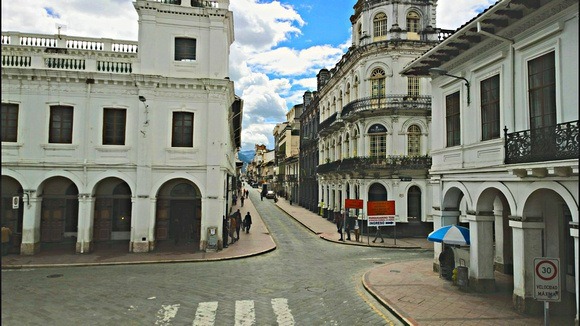
However. Shortly before I left Cuenca, I hit the town with a few friends to some bars. Something was slipped into one of my friend’s drinks. Although she made it home before something really awful could have happened, she fell unconscious on her way inside, requiring a hospital trip and stitches, where they took blood and confirmed that she had drugs in her system.
So although I was ready to wax poetic about how safe Cuenca is, I must temper any glowing review with a reminder that in any urban setting there is a higher propensity towards crime, and that educated caution and street sense are a traveler’s best friend. (See also Travel Safety for Women)
Exhaust and Noise
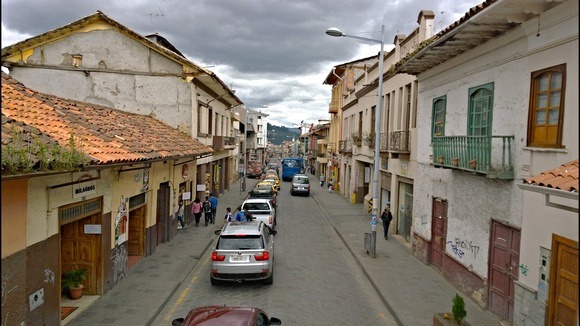
Not to be a miss-poopy-pants, but it’s worth noting that a certain level of noise comes with staying in Cuenca’s El Centro. There are some places tucked up and facing away from busy streets, but I was living on the third floor pretty much overlooking a busy intersection.
So, the car alarms. Car alarms! In my experience in South America (which so far has been Peru, Colombia, Bolivia, and Ecuador), I have observed that people like their car alarms. And that most car alarms seem to be hair-triggered. Just for a giggle, one day I counted out a 90 second time frame. Five car alarms (different ones), all rang out their cheery tune for varying lengths of time. It’s far from harmonious.
Other noise-filled delights that come with staying in (my part of) El Centro include competing discos and karaoke bars on weekends, and the ever-present low sickly growl of the buses lumbering along.
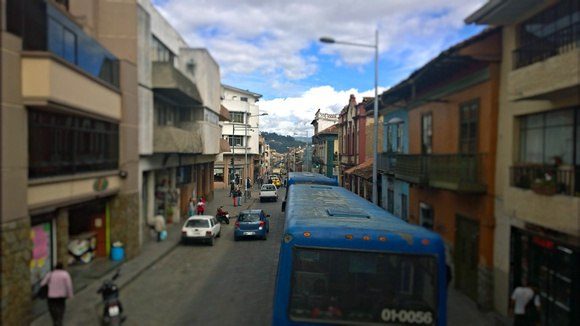
The buses are another thing entirely. These things consistently spew black clouds of exhaust. The backs of all the buses are black with it. I noticed that many people who work outside in the streets wear masks over their nose and mouth, and rightly so; I developed something of a smoker’s cough after my first couple of weeks in Cuenca.
But there’s hope. Once the Tranvia (a tram system currently under construction) gets underway, apparently there will be no buses at all in El Centro.
Now, I must temper my complaints of noise and pollution with the fact that I prefer living rurally. I love the pace and hum of urban life, but when given the choice I prefer to relax in nature. (The luxurious kind of nature, that is, with wifi and stuff).
When Dyanne was giving me the orientation for my house-sitting gig for her, I remarked on the noise and pollution. She said she’d just come from Vietnam, so if anything, Cuenca was quieter and cleaner. All things are relative.
So it’s quite possible that my tolerance for things like noise and fumes is lower than others. If I return to Cuenca, I would look for a place in El Centro that is up and out of the way of excessive noise/exhaust, and if I couldn’t find that, I’d find a place on or just south of the river Tomebamba.
Drinkable Water
It’s relatively common knowledge that the tap water in Cuenca is safe for drinking. This is because Cuenca’s water supply comes from the nearby lakes of the Cajas region, in the mountains. Most of Ecuador’s tap water isn’t potable, so the idea that Cuenca’s is, is met with a healthy dose of skepticism among visitors.
Because I drink a lot of water, I sterilized small jugs of it with my SteriPEN, just in case. But I thought nothing of brushing my teeth with it, washing my produce in tap water and not drying it, etc. And I’m pleased to say I felt no ill effects. Unlike, other places. In Peru for example, I suffered multiple parasites; oh the joy. (See also: Dealing With Parasites: A Guide to Clean Water Around the World)
INTERESTING FACTS AND PLACES
Here are some random things I learned or discovered while living in Cuenca:
The Home of Panama Hats
Panama hats are 100% Ecuadorian. These straw hats have been crafted in Ecuador dating back to the 1600’s. In the early 1800’s, when exporting these hats, everything from this part of South America first went to the Isthmus of Panama (pre-canal) for shipping. The hats ended up acquiring the name of their point of international shipping, instead of their actual country of origin. But Ecuadorans quietly know the truth.
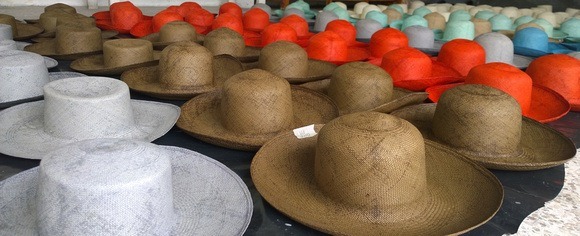
I learned this because I took two city-bus tours of Cuenca on a two-day ticket. Formerly not one to embrace highly touristic experiences, I’ve actually found that city tours can provide a nice overview, and go to a few places I might not otherwise see on my own (such as the El Turi lookout), and in some cases, you get an additional surprise.
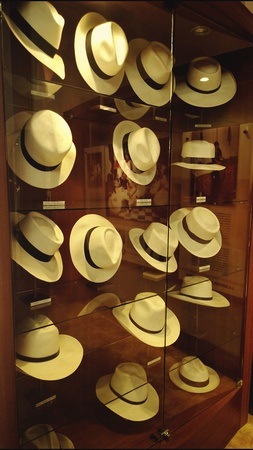
One such surprise was that we visited the Panama Hat museum – a place I surely wouldn’t have gone to on my own, but am all the more enriched to have seen. It’s a small miracle that, with my love of fedoras (they’ve practically become my trademark), I escaped without buying one.
Broken Bridge
In 1950, the flooding Tomebamba river took out a large bridge. It was never rebuilt, for reasons I couldn’t decipher – procrastination? Tribute to history? Found a better place to build a new bridge? All are possible. Now, Puente Roto (Broken Bridge) is an interesting (even aesthetically pleasing) landmark that is also a popular meeting place in Cuenca. I even filmed my last vlog there.
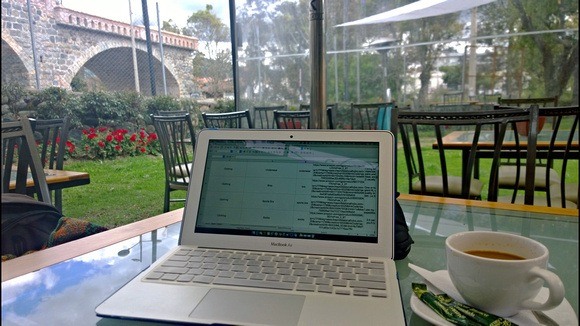
Hot Pool Oasis
Just outside of Cuenca is the village of Banos (not to be confused with the larger and popular town of Banos, further north in Ecuador). What both of these places hold in common, however, are their hot-springs.
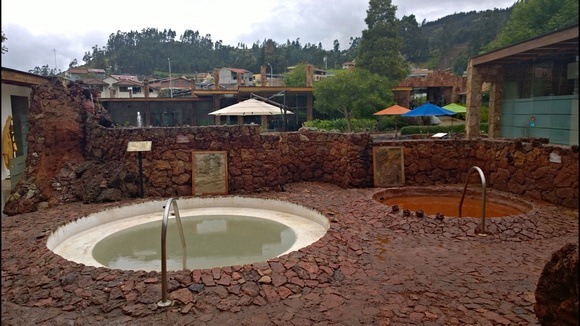
Piedra de Agua is a spa in Banos (Cuenca) not to be missed. I went twice. To get the full effect you need to drop $35 on the full spa circuit (they have 2-for-1 specials on Mondays if you bring a friend), which includes steam room, two different types of mud, another kind of steam, and then some underground hot and cold pools you can alternate to your heart’s content while sipping some lovely juice concoction.
If your budget is tight, then for $6 you can chill out in the large outdoor hot pool as long as you wish.
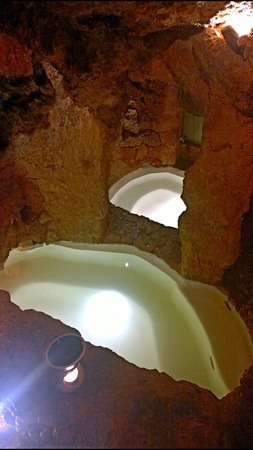
Where to Stay in Cuenca
Personally, I stayed (many times over the months ensuing since writing this article) at Del Parque Hotel and Suites which is oh so perfectly located overlooking the main square. The rooms are gigantic, well-appointed, and charming. Check out some other options here:
Booking.comThings to do in Ecuador
On the main square of Cuenca, you’ll find a few double-decker tour buses offering tours. I highly recommend taking one of these tours to orient yourself to the city! It’s a great way to cover a lot of territory, learn about the history and people, and access some great vantage points for pictures. Here are some other ideas:

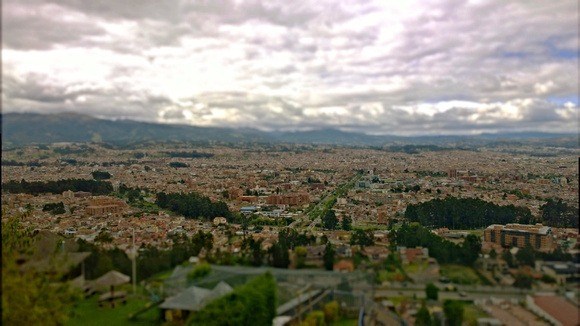

Nora,
My wife and I are seriously considering retiring in Cuenca. I have been 5 or 6 times and she once. I love the city, its history and I actually like the food. I lived there for 5 weeks a couple of years ago and never was bored. Including rent, my stay was under $1,000 and I ate out 40% of the time.
We have made many friends in Cuenca and wouldn’t feel alone if we decide on Cuenca. I had no idea you h were there for 6 weeks. I recognize the majority of your photos and the Panama hat photo looks straight out of the Humberto Ortega factory, where I bought two hats. I’m kind of known for hats also! LOL! Hope you are healthy and happy!
Mike
Hey Mike,
Yeah, overall, despite my few complaints, I too really liked Cuenca – and Ecuador in general. I look forward to exploring other parts of the country when I return next year.
Stay tuned for another (somewhat unrelated) post that stemmed from some conversations I had with people in Ecuador, who drastically overpaid for accommodation and such. Coming soon!
And yes – those pics are from the very same factory. Great place! I’m still amazed I didn’t buy anything. 😉
But the town of MonteCristi is where the hats are originally from, correct? The street is full of the people weaving these beautifully tightly-woven hats. I don’t know how they sell them for so little (as low as $40).
Thanks for sharing your experiences and travel tips for visiting Cuenca Ecuador. It does appear to be quite a different environment to what most of us experience – especially in contrast to our western culture. But that’s one of the best things about traveling – getting to experience and widen your views of the world by immersing yourself in another culture.
Hey Jane – Amen! Travel (for me) is all about expanding horizons and seeing other ways of living.
Great honest round-up Nora. I got turned off by all the exhaust and traffic in Cuenca as well, but once you get out of the city the countryside is lovely. It is kind of odd on the restaurant prices, as I ate at two places where a good set lunch was $2 or $3, but you can certainly spend a fortune at others.
I’m with you on the food too. Not as great as Peru, but certainly a huge leap up from most of Central America and Colombia as well.
Hi Timothy,
Glad you agree with my assessment! I’ve enjoyed my time in the countryside outside of Cuenca; makes visits into town all the more enjoyable too!
Ha, yes the local comida typica is a little on the same ol’ same ol’ side. BUT you must try Tiesto’s to enjoy true upscale Ecuadorian foods. Expand to the encebollados and locro de papas – this country has the BEST soups. It is a shame the Coopera restaurant closed – it was the best local food, not boring. I recommend the encebollados on Virachochabamba down from Clinca la Paz. Not there now, but I’ll probably be back. Great description of Cuenca. I love the contrast of old and new – like the drone that was flying in the Old Church in Central before the symphony performance. Such a contrast.
Thanks, John!
And you’re right – Ecuador has soup dialled in! I second your vote for encebollado and locro de papa. 🙂
Could you give more specifics on your friend having her drink drugged at a bar? How do you think it happened?
Hi Kendra,
We’re not exactly sure how it happened. It was either a free drink she was offered in which there was something, or perhaps something being slipped in to an existing drink when we weren’t looking. Moral of the story: don’t drink anything that you haven’t had your eye on 100% of the time since it was poured!
Ecuador has amazing food…you just have not tried yet.
Hi Isabel,
I’m sure of it! What is your favourite Ecuadorian food?
encebollado, caldo de manguera, bandera, ceviche de concha, ceviche de calamar / pulpo, scallops, hornado, guatita, locros, mote pillo, mote sucio, etc, etc. Your mistake was going to the restaurants which btw are owned by gringos, you should’ve gone to eat at mercado central.
Yo,
If you actually read what I wrote, I mentioned that the Ecuadorian food I had was good, contrary to what other people had told me. And yes, I did eat at the mercado central, many times. You assume I ate at gringo restaurants. I dislike it when people make assumptions.
You have to try caldo de bolas, made of plantain balls with meat, hard boiled egg, raisin and more inside and the soup has potatoes, cabage and more.
We checked out Cuenca a few years ago and feel much the same way you do. Although the food available in the markets was gorgeous and if you like cooking you’d be in heaven, the restaurant scene did not charm us. I really didn’t like the pollution, and we found that once it was dark at 6 or so, there wasn’t much outdoor life going on — too cold. I love a cafe and terrace culture — eating outside at night, lingering over a glass of wine, etc., which we found lacking. Much as we loved most of our stay there, we didn’t retire there for these and other reasons.
Interesting analysis of Cuenca from a retirement destination point of view! And yes, given your preferences for a warm evening cafe culture, Cuenca would be a stretch.
Where to next in your search?
Loved your colorful…and accurate depiction of so much that I’ve seen and love about Cuenca. I agree, overall, with your assessment of the food scene, though there is good Indian, Turkish and Lebanese food in addition to the Italian, French and Western choices that you mention. I’m a little surprised by your cost assessment, though. I find the non-Ecuadorian food prices surprisingly high but not equal to what we were used to paying in Atlanta, Georgia. More like 70-80% of Atlanta prices for similar food. Additionally, price is often tax inclusive and tipping is not expected, though we often left modest tips of 5-10%, which seems to be much appreciated rather then being considered “cheap”. Clearly, everyone’s experience is different and it’s not always easy to compare ? apples to apples ?!
Hi Reginald,
You make a great point about tips not being expected (which very much affects the bottom line), and I would also say you’re on the mark with the price estimates as being 70-80% of US prices. Thanks for commenting!
Hello Nora question do you really have to sterilize the water? I would like to retire there , me being a single woman and don’t have a clue about foreign Country like Cuenca , would you recommend that.
Hi Barbara,
Well, as I state in my article, apparently the water in Cuenca is drinkable, but since it isn’t pretty much anywhere else in South America, I didn’t want to risk it.
I think before you decide to retire there, you would do well to visit Cuenca first (by the way, Cuenca is a city, in the country of Ecuador).
Thank you.
Hello Nora i have a question about health care how does it run, do you pay once a month and a copay to see doctor? And if you need sergery( which i do not need) just in case i move there and needed surgery how much would it cost could you please explain the health care system please. Thanks Barbara
Hi Barbara,
Christopher below provides some good tips about how the health care system works in Ecuador.
Considering that you are contemplating moving to Ecuador, I HIGHLY recommend my colleague’s book about moving abroad. He profiles a lot of hot destinations for retirees and answers all the questions you have had so far for me, and so many more.
Here’s my review of the book and the services he provides: https://www.theprofessionalhobo.com/the-creative-guide-to-free-or-cheap-accommodation/#expat
I can say this much: Ecuador government – sponsored health care is available to anyone worldwide. There is no co-pay or deductible. But if you live there, you need to pay into it each month. On the other hand, many of my friends go almost always to a private clinic for specialized care (i.e., eyes) and for that you pay at the time of treatment whatever they charge. For example, I had a complete eye exam (including color test, dilations, etc.) for Pilot’s medical evaluation, and it cost me $10.